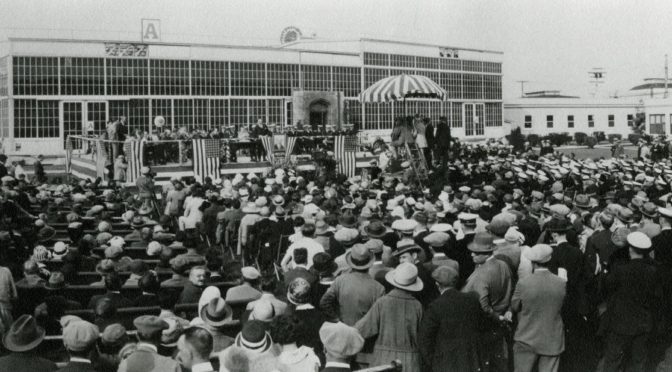Metro-Goldwyn-Mayer began in 1924 with the merger of Metro Pictures, Louis B. Mayer Productions, and Goldwyn Pictures. It was a package costing $5 million. The new owner was Marcus Loew who owned a chain of theaters. He had already bought out Metro Pictures and its studio in Hollywood, but was unsatisfied with its productions. Louis Mayer met with Marcus Loew and arranged for the new company to be run by Mayer, with the head of production to be the “boy wonder” from Universal, the 24 year old Irving Thalberg. Loew, HQ’d in New York, would have Nicholas Schenck overseeing operations from that office. The studio lot they took over was the Samuel Goldwyn lot in Culver City, once the Triangle Film Corp. lot. They also took over Goldwyn’s logo of Leo the Lion and his motto, Ars Gratia Artis (art for art’s sake). Samuel Goldwyn had walked away from the company after battles with its controlling Board.

The Metro Studio at the intersection of Romaine and Cahuenga in Hollywood before the merger.

Above is the Metro Pictures studio lot in Hollywood. These are the stages and shops before the merger. Located at 1025 Lillian Way in Hollywood.
This blog post celebrating the 95th anniversary year of MGM is part of the Classic Movie Blog Association 10th Anniversary Blogathon. Given MGM’s long and deep movie history, this post will focus on its formative years.
From the beginning, Mayer, Thalberg, and studio operations man Harry Rapf set out to go big and go classy. Mayer’s policy was, “…great star, great director, great play, great cast.” To do that they needed to quickly develop their roster of directors and stars. This was paralleled in the crafts people they hired for a variety of studio jobs, from costume designers to metal workers. Mayer and Thalberg brought in noted stars Lon Chaney, Norma Shearer, and Renée Adorée, along with directors Fred Niblo and John M. Stahl. Metro had Ramon Navarro, Alice Terry, Viola Dana, Jackie Coogan, Buster Keaton, and Mae Busch, along with director Rex Ingram. The Goldwyn Pictures group included Mae Murray, Conrad Nagel, Aileen Pringle, John Gilbert, William Haines, and Eleanor Boardman. The directors included King Vidor, Marshal Neilan, Erich von Stroheim, Robert Z. Leonard, and Victor Seastrom. Two department heads became significant additions: Howard Dietz in Advertising and Publicity, and long-time Art Director Cedric Gibbons. And another Goldwyn tie-in was the Cosmopolitan Production Company, Randolph Hearst’s company set-up to produce films for Marion Davies.

A public ceremony was held to celebrate the merger and launching of Metro-Goldwyn-Mayer (MGM) on April 26, 1924. The former Vice-President of Samuel Goldwyn, Abraham Lehr, handed a giant key of “Success” to Louis Mayer, Irving Thalberg and Harry Rapf. After their speech Master of Ceremonies Will Rogers arrived to give his rather long talk, only to be interrupted by director Marshall Neilan who ordered his cast and crew to return to the set to work on Tess of the D’Urbervilles. This head-strong director was not the only one on the roster. Erich von Stroheim, the hold-over from Goldwyn, was well into shooting his 42 reels of Greed . His struggle with Thalberg and the cutting of the film to 10 reels is a movie legend. And that was not the only troubled production. Another Goldwyn film, Ben-Hur, was being shot on location in Egypt and Italy and had spent its already large budget building grand sets and used up months of filming. Thalberg and Mayer were unsatisfied with both the results and the pace of production. The film’s director and lead actors had already changed once., so the production was recalled to California. By the time Ben-Hur was finished, it had cost $6 million, a staggering sum for its day. Fortunately it was a big hit for MGM and its stars Ramon Navarro, May McAvoy, Francis X. Bushman, Betty Bronson and Carmel Myers.

The photo from 1925 above shows the first sign with the full name of Metro-Goldwyn-Mayer. The glass sound stage was “Stage 1.” The lawn area in front, only partially shown, is where the launching ceremony of April 1924 was held. This area would soon be covered over with concrete sound stages and the Sound Department building.
The Goldwyn Studio property in Culver City was 39 acres, the original Triangle Studio’s 16 plus 23 more acres that Goldwyn purchased. Six glass sound stages were on the property along with various buildings. The glass sound stages were needed in the early days of filmmaking to provide sufficient natural lighting.
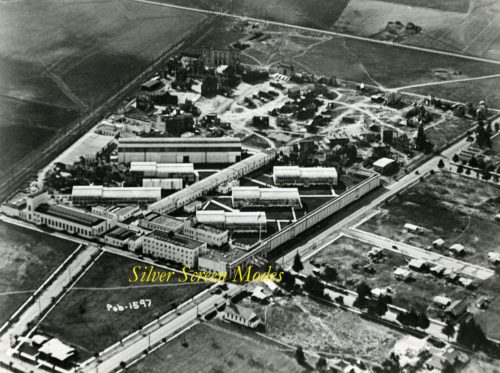
The photo above shows the Goldwyn lot in 1924 with the six sound stages and other buildings. The classic facade on Washington Blvd was already there when MGM began, shown on the right of the image. Standing sets are at the rear of the photo.

The photo above shows the MGM lot in 1924. It shows the old water tower without the MGM logo. The tree in the foreground is a fig tree where Greta Garbo used to pick figs when she first arrived from Sweden. Men’s Wardrobe is the building at the lower left.

The above photo shows a glass sound stage on the right and the old dressing rooms on the left. The upper floor was the ladies’ dressing rooms. Workers are preparing the grounds for new concrete sound stages. The glass stages were moved for other uses.
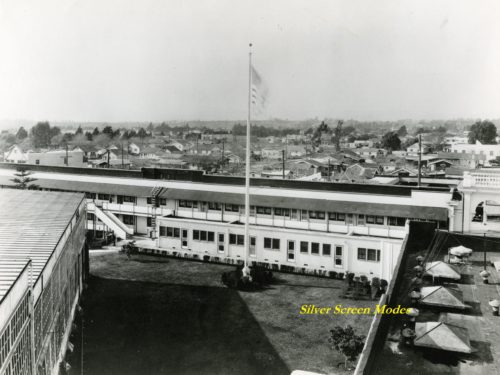
The photo above also shows the old “dressing room row”in the background with the grassy area in front as it was at the time of the beginning of MGM. Behind it was the MGM facade facing Washington Blvd.
The first film that MGM produced on its own was He Who Gets Slapped. The film featured three of its future stars, John Gilbert, Norma Shearer, and Lon Chaney. And despite its drole title, the melodrama was a commercial and critical success when released in October 1924. The year of 1925 brought much more success for MGM with revenues second only to Paramount. Ben Hur was released as a giant epic and would have made a big profit had it not been for a revenue-sharing deal made by MGM’s predecessor. But its own big epic was the World War I-based film The Big Parade. The film made stars out of John Gilbert and Renée Adorée , with their parting scenes leaving no dry eyes in the house. The battle scenes too were very realistic, though shot in Griffith Park in Los Angeles. The film made $6 million for MGM. And MGM had such diverse offerings as the creative and funny movies of Buster Keaton (first coming with Metro) in Go West and Seven Chances. Then there were the horror movies of Lon Chaney in The Monster and The Unholy Three. Further diversity was introduced with The Merry Widow, where increasingly popular John Gilbert was paired with former Universal Pictures star Mae Murray in a setting of an old world kingdom. The film’s director was Erich von Stroheim, which led to a turbulent set with shouting matches and walk-outs between director and Ms. Murray. and the Gilbert. The result, however was a big popular film that swept fans like Diana Vreeland off their feet. But perhaps the biggest event of 1925 was the signing of two new actresses to the MGM roster: Greta Garbo and Joan Crawford (then with the last name of Le Sueur). Ms Garbo was 20 years old and had just come from Sweden. She starred in the melodrama Torrent, released in early 1926. Joan Crawford played uncredited bit roles in several films, even doubling for Norma Shearer in one film. She finally got a break in late 1925 in Sally, Irene and Mary, co-starring Constance Bennett and Sally O’Neal. The story is about three showgirl friends with very different fates. Two of the biggest stars of Golden Age Hollywood were on their way.
In 1926 MGM starred an actress already well known and respected. Lillian Gish came to make La Boheme with John Gilbert. Louis B. Mayer gave her considerable control when signing her to MGM, and she used it to make this picture. King Vidor directed, and much time was spent in rehearsals. MGM had spent much time and effort to lure Erte from Paris to design costumes for the studio. He designed the costumes for Miss Gish for La Boheme, but they disagreed on their look. He wanted crisp and stylish costumes befitting her star status. She said they should depict her life as a waif in Paris. This was one more frustration that led to Erte’s departure soon after. But La Boheme was another hit for MGM, and rated one of the best movies of 1926.
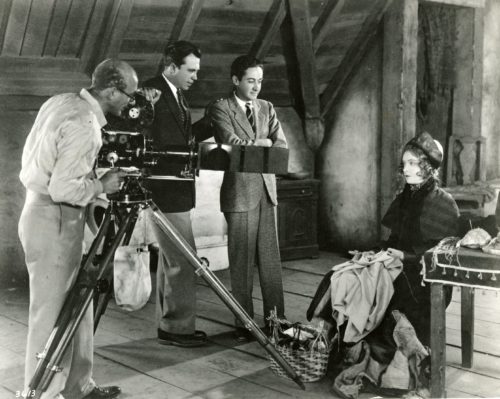
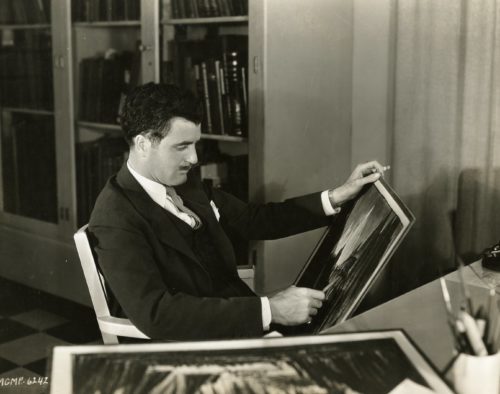
The photo above shows Cecil Gibbons, MGM’s Art Director. He came with the Goldwyn merger, and stayed until 1956. He was one of the original founders of the Academy of Motion Pictures Arts and Sciences, and designed the Oscar statuette.
MGM introduced the first true musical film with its “All Talking, All Singing, All Dancing,” movie The Broadway Melody in February 1929. This made musicals very popular but sound ruined the careers of stars with heavy foreign accents or those whose voices didn’t match their personas, as in the case of John Gilbert.
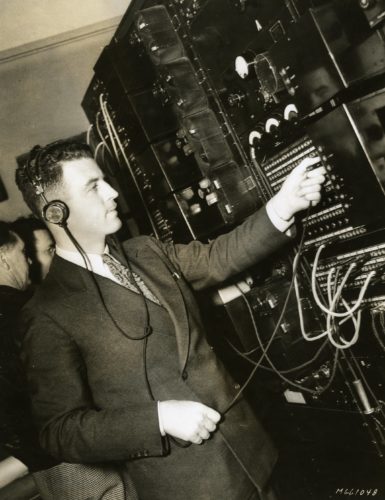
MGM recording director Douglas Shearer is shown above with his sound recording equipment. He was Norma Shearer’s brother.
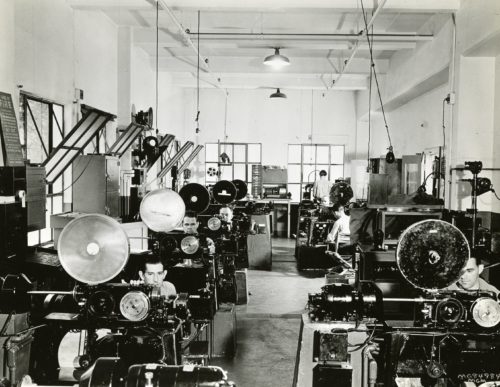
Above is pictured MGM’s Recording Room.. Each of the machines is connected to a microphone at a stage and records voice, song, or music on film “sound tracks.”

The photo above shows a part of the MGM lot with a sound stage roof painted with huge letters intended for aircraft to avoid flying overhead. In 1929 Mines Field was built nearby as the Los Angeles airport just as “Talkies” were being made at MGM.

Above is pictured the old Guard Shack at MGM, at the old entrance from Washington Blvd. The gate was narrow and only one car width, where everyone would check in with the guard.

Here’s a morning’s worth of check-ins from the mid-1930s. Not just for studio P.R., but Joan Crawford and Greta Garbo were the compulsive early starters.
By the 1930s, as MGM publicity emphasized, the studio had more stars than in the heavens. It would be many decades before the studio’s demise. And in the years before and following World War II, it was the biggest and most profitable studio in Hollywood. Ars Gratia Artis. Thankfully, we can still enjoy viewing the majority of those movies through a variety of methods and formats.
Further view of the old MGM lot can be seen on my blog post at: https://silverscreenmodes.com/a-virtual-tour-of-the-old-m-g-m-back-lots/
Views: 527

